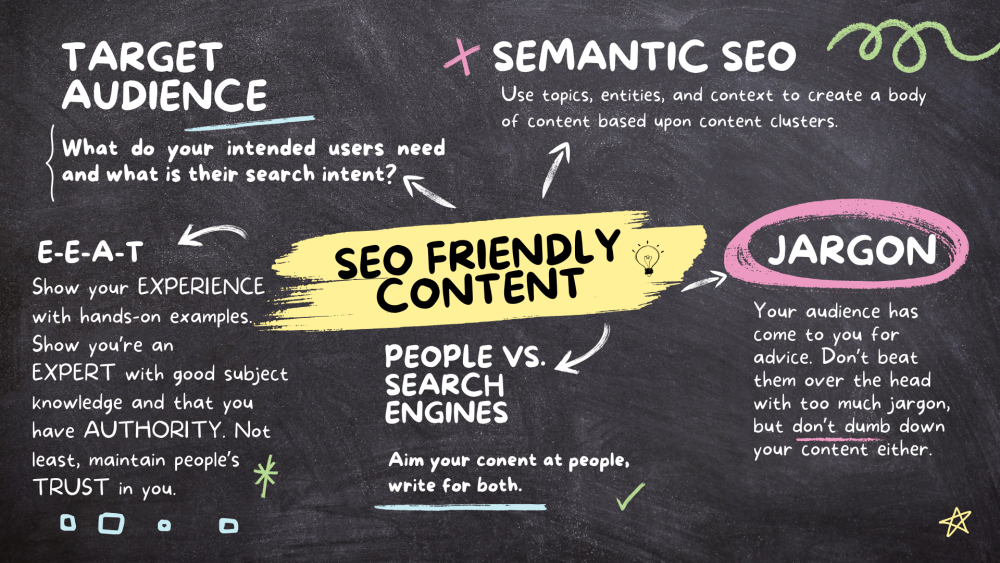
Here is my next article cover the various aspects of SEO. Last time it was the title, this is about how to write SEO friendly content for a website.
In the olden days, it was probably true that creating SEO-friendly content meant considering the search engines first and foremost, with keywords the key metric. Nowadays, although the search engines are obviously still important and keywords still have their place, you now need to deliver information in a way that resonates with both your audience and the algorithms.
In this article I’m going to give you a rundown on the key aspects that make content SEO-friendly. And let me reiterate that this isn’t just about rankings; you must provide added value for your readers. In fact, you can’t get rankings without giving value.
At the core of SEO-friendly content is a solid understanding of user need and search intent. Essentially, you need to know what your audience is looking for and why. Is it information they are after; or are they trying to make a purchase; or is it a service they seek?
Your content needs to address these intentions directly. To do this effectively, you need to carry out keyword research. That is, identifying the phrases and questions that people type into search engines when looking for content like yours.
The secret to success is balance. In the next section, I will go through how you can strike just the right one between writing for the algorithms that index and rank content on the one hand, and the people who read and get value from it on the other. That’s a crucial part of what makes content SEO-friendly.
Your Content Must Resonate: People-First Writing
If you want to strike a chord with your audience, you’ve got to put people first. This approach is fundamental not just for keeping readers hooked but also for achieving higher SEO rankings. So, how exactly do you put people first with your content?
It’s easy to say but perhaps a little more difficult to put into effect, but people-first content is the kind of material that addresses the reader’s concerns, questions, and interests. You write it in a way that’s conversational, engaging, and most importantly, helpful. It avoids getting caught up in SEO tactics that interrupt the natural flow of information.
Top tip: Just write. Consider your topic first and foremost and write with it front and centre. Don’t attempt to force fit keywords.
For a start, your title will have done much of the work here anyway – in setting the question that your article is addressing. The time to consider your keywords is after drafting your post. At this point, revisit them keywords and naturally integrate them into your content where they fit seamlessly, without disrupting the flow or readability.

It should go without saying but you should focus on making your content relatable. Use real-life examples, anecdotes, and even a bit of humour when appropriate. Always be mindful that it should help or interest the person reading it. If it doesn’t it won’t work.
A great way to captivate your readers is through storytelling. Everyone loves a good story, so incorporating them into your content can make complex or dry topics much more absorbing. It’s a powerful strategy to maintain reader interest and keep your content memorable.
Lastly, for content to truly resonate, it should be easily understood. Steer clear of jargon and complicated sentences. Use clear, concise, and accessible language. It’s not about dumbing it down. Do not patronise your audience in that way. Just make sure that your content is inclusive and can be appreciated by all.
Using technical language is well and good at the right time. Make sure that clarity is your guiding principle and if you do use technical language, make sure that you explain it fully. It’s not about you, so think of it as keeping the focus on the reader’s experience. This way, you’re much more likely to hit the SEO targets indirectly through increased engagement and time spent on your website.
Feeling hungry? Next up, how applying the principles of E-E-A-T complements people-first content and bolsters its effectiveness in satisfying both your readers and the search engines.
Elevating Credibility: Applying E-E-A-T Principles
When it comes to establishing yourself as a go-to source in the digital world, there’s a big picture idea you should never overlook: Experience, Expertise, Authoritativeness, and Trustworthiness, collectively known as E-E-A-T. We’ve touched on them before, but since Google cares deeply about these factors, you should too, especially if you want your website to rank well. They’re worth then, a brief recap.
Experience speaks to your hands-on involvement and familiarity with the topic. Sharing personal anecdotes or case studies is one way to showcase this. Expertise, on the other hand, is about possessing advanced knowledge or skills in a particular area. Your content should reflect this depth by covering topics with accuracy and insight.
But having expertise isn’t enough on its own. You also need to convey authoritativeness. This involves establishing your reputation within your field. Garnering positive reviews, being cited by reputable sources, and contributing to influential publications can signal to search engines that you’re an authority worth listening to. Think about your off-page SEO strategies here.
And finally, trustworthiness is the linchpin of it all. You build trust by consistently providing reliable information, citing reputable sources, and being transparent about your content creation process. A website’s security also contributes to this sense of trust, so make sure your site has an SSL certificate and provides a safe environment for visitors.
Applying E-E-A-T principles isn’t just about ticking boxes for a search algorithm; it’s about creating a positive and informative experience for your users. They are lived values. By doing this, you not only climb the SEO ladder but also establish a loyal following who trust what you have to say.
With a solid understanding of E-E-A-T, the progression into SEO tactics that go beyond the mere sprinkling of keywords becomes quite intuitive. It’s about enhancing the overall content experience on your site, which I’m going to discuss in the following section.
Modern SEO Tactics – Beyond Keywords and Single Articles
You’ve learned the essentials of creating content that genuinely meets the needs of your users, with trustworthy, authoritative information. Now, I’m going to show you why embracing modern SEO tactics is about way more than just keywords.
I’ve said it before, but it really bears repeating. It’s not just about dropping in a few key phrases and expecting to rank at the top anymore. We are going to dig into semantic SEO and how it allows you to build relevance in a smarter, more natural way. Think of it as speaking Google’s language – by focusing on topics, entities, and context, you can clarify the intent of your content and not just one article, but a range of them, written in topic clusters.
The essence of semantic SEO is the optimization of content based on the intent and contextual meaning behind user searches, rather than focusing solely on exact-match keywords.
It’s about the relevance of topics, entities, and context within content creation. Therefore, you should devote time to identifying the related topics and entities (people, places, objects, concepts) associated with your main subject. From this analysis, you can make a comprehensive content creation plan. Once you put this into practice, search engines will begin to view your content as authoritative and you as an authority.
Search engines use natural language processing to analyse the relationships between these entities and the context in which they’re mentioned to better match content with user intent. By aligning your content strategy with semantic SEO principles, you enhance your content’s visibility, as search engines can more accurately interpret and rank it in relation to users’ search queries.
Finishing Touches to Your Content
Briefly, let’s touch on the issue of readability and the use of multimedia. When you are writing with your audience in mind, structure and readability should be at the forefront of your efforts. But these have a benefit for the search engines too. A well-structured article with clear headings, bulleted lists, and short paragraphs can work wonders for both user experience and crawlability.
And let’s not forget multimedia. Incorporating images, videos, infographics, and even podcasts can help to bolster engagement and keep your audience on your page longer — a signal to search engines that your content is worth ranking.

Lastly, robust link building will help to boost your site’s authority. This includes obtaining backlinks from reputable sources, internally linking to your own valuable content, and always keeping user experience at the forefront.
Remember, the optimisation of your SEO is a constantly shifting dynamic. What works today may need nudging one way or another tomorrow. You can always adjust your approach down the road. Keep your eye on the ball and your ear to the ground. There’s a lot of opportunity in staying adaptable and informed in the world of SEO.
